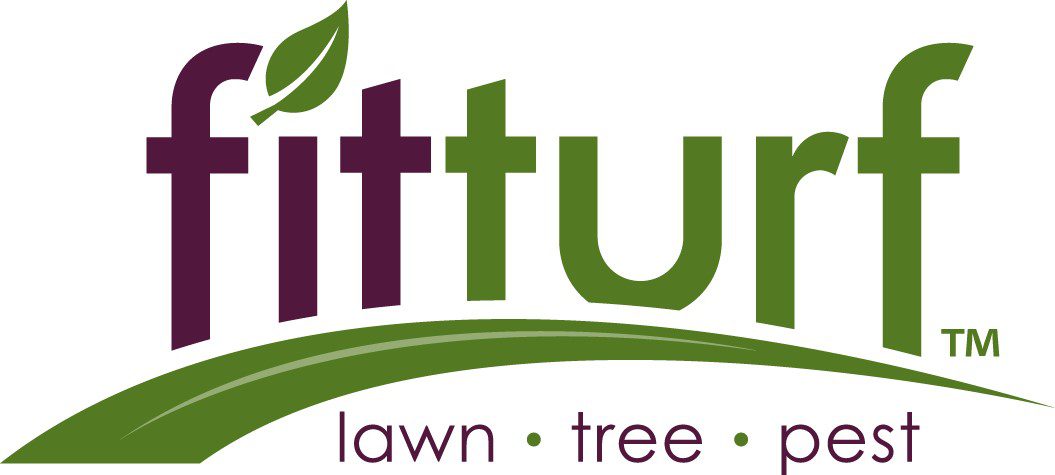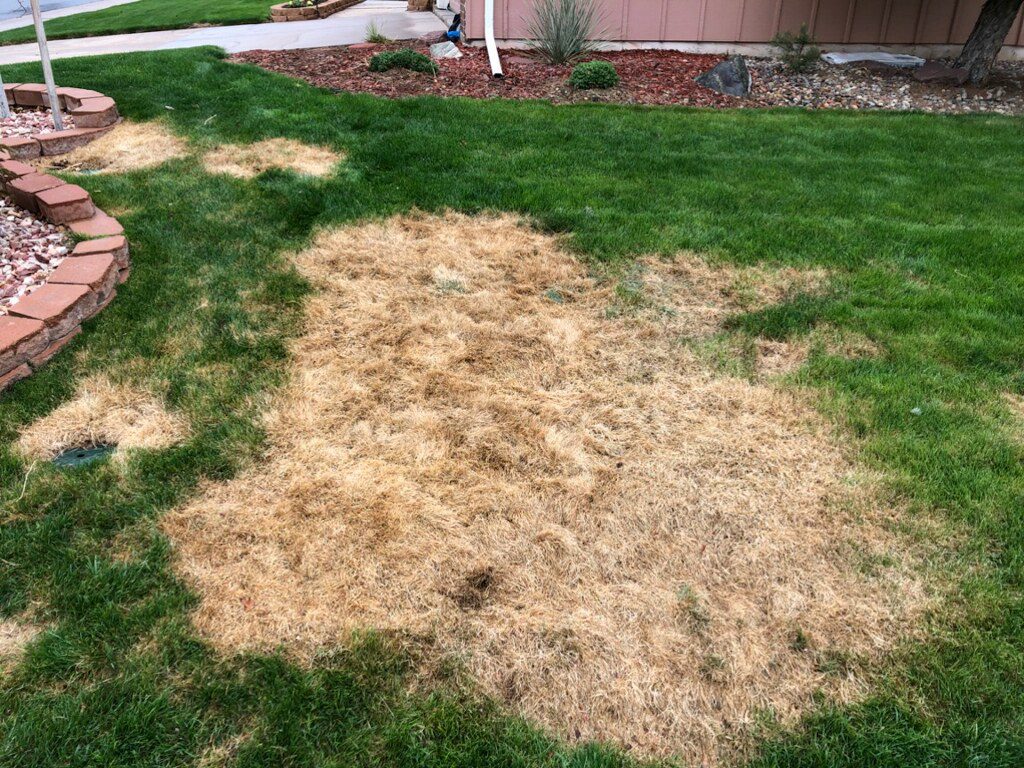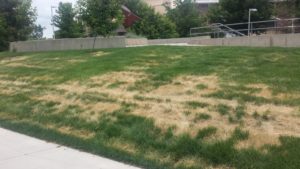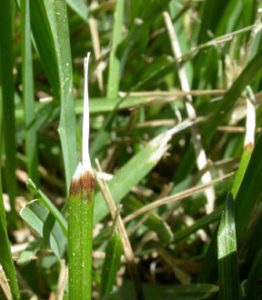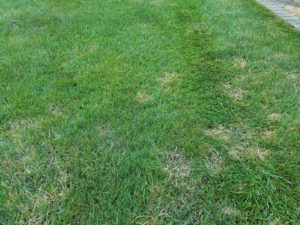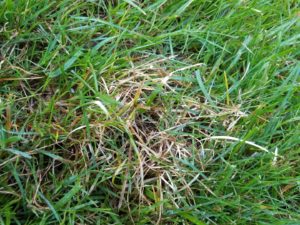Customer Support
303.221.6900You may suspect that you have a lawn disease affecting your lawn, but if you don’t know which type you have, then how can you treat it? The experts at Fit Turf know exactly how to identify different types of lawn fungi in the Colorado area, and this Learning Center Resource will help you to learn how to identify disease as well.
Necrotic Ring Spot
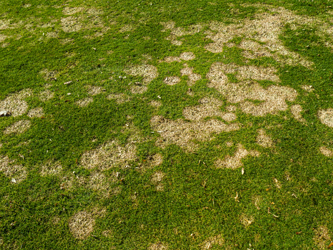
Ophiosphaerella korrae
Necrotic Ring Spot is the most common home-owner turf disease, and is the most destructive disease of Kentucky bluegrass in Colorado. NRS is a perennial disease associated with Kentucky Bluegrass, zoyziagrass, as well as other grass species. Necrotic ringspot is caused by a soil-borne fungus called Ophiosphaerella korrae.
DAMAGE:
NRS appears as 6-12 inch circular spots or patches of dusty orange-colored turf in mid-late summer. Grass may recover in the center of patches or be replaced by grassy weeds, giving a “frog-eye” appearance. At times, the disease appears as rings and arcs. Foliar symptoms include entire leaf blighting. Root symptoms include dark brown or black roots, stolons, rhizomes, and crowns. Early detection is key for control.
DISEASE CYCLE:
Infection occurs in the spring or fall, but symptoms develop in the summer when the turf becomes stressed. The fungus survives from year to year on dead, colonized bluegrass roots and crowns or on the surface of living roots. The fungus actively colonizes the outside of roots at soil temperatures between 65° and 80° F. These temperatures occur from mid- May through mid-September along the Front Range, but may vary somewhat on the Western Slope and at higher elevations. Infection spreads outward until some of the patches coalesce, producing a large blighted area. Necrotic ringspot is particularly damaging to bluegrass because it is a perennial problem and the fungus attacks and kills the roots and crowns. Thus recovery from a disease outbreak is slow. However, because of its perennial nature, NRS may reappear and intensify in mid-summer in successive years. NRS results from poor site prep, excessive management inputs, thatch, and poor water infiltration.
IPM METHODS :
- Core aeration & over-seed
- Avoid excess N
- Mow at 3 inches
- Water deeply and infrequently
- Begin fungicide applications in the spring after the soil temperature has reached 60 degrees
Ascochyta Leaf Blight
Ascochyta spp.
ALB is characterized by large uniform areas of straw colored turf. Pockets of infection may cause a patchy appearance. Closer examination of the turf shows healthy leaves dispersed with infected leaves. Individual leaf blades usually start dying back from the tips. This bleached area extends toward the leaf base. The margin between the diseased tissue and healthy tissue develops an abrupt pinched appearance.
DAMAGE: ALB is a common problem on KBG lawns. The fungal disease attacks Italian and perennial ryegrass and tall fescue.
DISEASE CYCLE: ALB can occur throughout the growing season, but is more prevalent in the spring during extended wet periods. ALB fungi overwinter on dead tissue. In the spring, when it is wet, the fungus produces spores that ooze out of tiny black fruiting structures called pycnidia. Splashing rain, lawn mowers, other turf equipment, or shoes spread the spores to other grass blades, where they usually enter the freshly cut ends of the leaf blade.
IPM METHODS :
- Irrigate and avoid water stress
- Mow grass to a height of 3”
- Reduce thatch and remove clippings
- Apply Broad Spectrum Fungicides
Leaf Spot and Melting Out

Bipolaris sorokiniana and Drechslera poae (Helminthosporium spp.)
Leaf spot and melting-out are two fungal diseases of turf grass within the “Helminthosporium” leaf, crown, and root disease complex. Leaf spot and melting-out are the most common and serious cool-season turf grass diseases in N. America. Affected turf of both diseases show thinning of turf, irregular distribution across turf stand, and leaf spotting. When disease is severe, entire plants die.
DAMAGE:
Early symptoms of leaf spots are small, dark purple to black spots on the leaf blade. Oder lesions are round to oval spots with buff-colored centers surrounded by a dark brown to dark purple margin. The leaf spotting symptoms of melting-out on KBG are very similar to those of leaf spots; small dark lesions that develop into oval spots with buff centers and dark purplish-black margins on infected leaf blades. Colonization of the leaf sheath causes the leaf to turn yellow, then tan, and eventually drop from the plant. This stage is known as ‘melting-out’.
DISEASE CYCLE:
Leaf spot disease appears during cool, moist weather, in either spring or fall. The pathogen survives in leaf litter and debris and in infected plant tissue. A wet leaf surface is needed for the pathogen to germinate and infect. It is then spread by wind, rain, irrigation, and equipment. Infection can take place at any time that the soil is not frozen.
Melting-out disease is active during warmer weather. Under these conditions, severe turf loss occurs within 3 weeks. Cyclical periods of wetting and drying stimulate spore production. The pathogen is transported on infected leaf fragments that cling to shoes, mowers, and other equipment.
IPM METHODS :
- Balanced fertility—avoid over fertilization
- Water turf grass early in the morning and water deeply.
- Avoid frequent, short irrigation.
- Reduce thatch and remove clippings
- Use resistant cultivars in new plantings
- Apply broad spectrum fungicides every 14-21 days (or based on product label for targeting this pest).
Dollar Spot
Sclerotinia homeocarpa
Dollar spot can be a serious problem of Kentucky Bluegrass. Presence of dollar spot in a well-managed lawn affects its aesthetic appearance and value, but usually does not threaten its survival.
DAMAGE:
Individual grass blades infected with dollar spot develop a lesion that is first chlorotic (yellow), then water –soaked, and finally a bleached-out or light tan color. The lesion may be up to an inch in length, usually spans the width of the blade, and is characteristically bounded on either side by reddish brown bands. Each spot seldom exceeds 2 inches in diameter. Fungal signs may include mycelium.
DISEASE CYCLE:
The fungus survives as mycelium in debris and plant tissue. Disease development is favored by warm days, cool nights, heavy dew, humid weather, low N levels, and dry soil. Dollar spot fungi are spread with the transport of infected sod or clippings and my mowers and other maintenance equipment. People, animals, water, or wind may also spread the pathogen. Disease occurs in spring, summer, or fall.
IPM METHODS :
- Balanced fertility—raise N levels
- Avoid moisture stress
- Water early morning
- Remove dew early morning
- Raise mowing height and mow often
- Use fungicides
Pink Snow Mold / Microdochium Patch
Microdochium nivale
Microdochrium patch is characterized by circular spots, from 4-12 inches in diameter. Within these spots, the grass is bleached and matted. Some spots may be a uniform bleached color and others may have a bleached center with a rusty-brown or salmon-pink border. The scattered spots are easily detected, even in mid-winter, because of the contrast in color between the diseased spots and dormant turf.
DAMAGE:
An infected turf grass stand will have spots, circles, and patches (4-12 inches). Leaves will exhibit blight and may turn pink, white and tan. Fungal signs may include mycelium and spore-masses similar to jelly.
DISEASE CYCLE:
Can injure turf any time during prolonged cool, wet weather. The pathogen survives during dormant periods in diseased grass plants or in dead leaves in the thatch. When temperatures and moisture conditions favor infection, the fungus produces thousands of spores on previously infected plant tissue. These spores and diseased leaf fragments are spread by through the affected area.
IPM METHODS :
- Balanced fertility—avoid high N
- Cut grass short in fall to avoid mats
- Remove snow until ground freezes
- Apply protectant fungicides
Typhula Blight / Gray Snow Mold
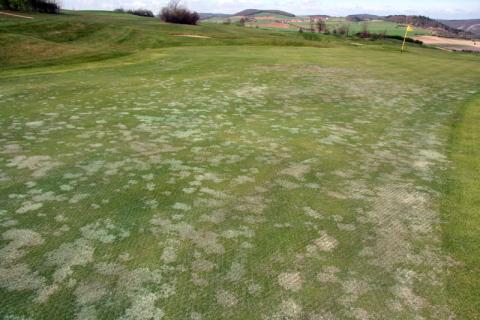
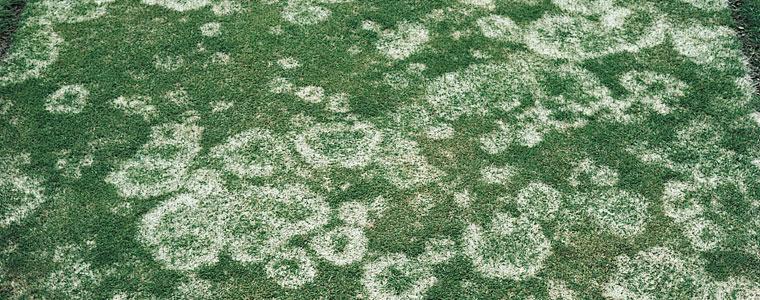
Typhula incarnata & T. ishikariensis
Typhula Blight is galled gray snow mold because of the characteristic dirty-white to gray mycelium formed by Typhula incarnata & T. ishikariensis on infected turf. Patches of rough, dead, bleached-brown areas up to a foot in diameter become visible as melting snow recedes from infected areas. These patches appear scalded, with leaves being matted together. They are often covered by a whitish-gray moldy growth. As the grass dries, the leaves become silvery white, brittle, and encrusted over the patch.
DAMAGE:
An infected turf grass stand will have circles, blighting of entire leaves, and leaves that are turned white. Fungal signs include sclerotia.
DISEASE CYCLE:
Typhula Blight is strictly a cold-weather disease. The gray snow mold fungi spend the warmer months as scelerotia embedded in infected grass blades and in the turf canopy. The sclerotia are very black to orange structures that can survive hot, dry conditions. Heavy moisture and nearly freezing temperatures trigger germination a and infection of grass plants.
IPM METHODS :
- Balanced fertility
- Cut grass short in fall to avoid mats
- Remove snow until ground freezes
- Apply protectant fungicides
Fairy Ring
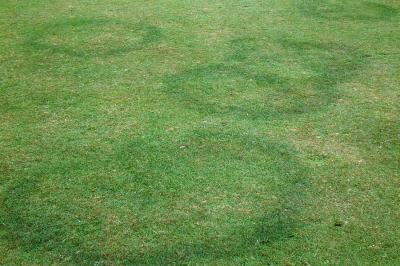
Various fungi
Fairy ring is a common disease of most turf grass species. Damage is often unsightly and sometimes a serious problem even on well-maintained lawns.
DAMAGE:
Early symptoms of infection by fairy ring appear as circular or partial ring-bands of lush green grass that vary from less than 1 foor to many feet in diameter. Most rings range from 3-12 feet, but can grow outward 2 inches to 2 feet or more per year. Eventually the deep green grass in the ring-band dies. This pattern of lush and dead grass may be visible throughout seasons. Mushrooms or puffballs of the fungus may appear in the rings following periods of wet weather.
DISEASE CYCLE:
Fairy rings result when saprophytic fungi feed on dead organic matter in the turf. The lush zone in the ring-band occurs because the fungi release N as they decompose the organic matter in the thatch and soil. The dead zone contains grass plants that may be killed or dormant, mostly as a result of an extensive network of mycelium or dense mold produced by the fungus. The mycelial layer prevents water from infiltrating into the soil and reaching turf roots.
IPM METHODS :
- Core aeration
- Mask with multiple applications of N
- Remove buried organic matter
- Proper irrigation management
- Fungicide with surfactant
Powdery Mildew
Various fungi
Powdery mildews produce mycelium (fungal threads) that grow only on the surface of the plant. The fungi feed by sending haustoria, or root-like structures, into the epiderma (top) cells of the plant. Powdery mildews are characterized by spots or patches of white to grayish, talcum powder-like growth. Tiny, pinhead-sized, spherical fruiting structures that are first white, later yellow-brown, and finally black may be present singly or in a group. These are the overwintering bodies of the fungus.
DAMAGE:
If leaves are infected heavily, they turn yellowish, and then tan to brown as they die. The plants are weakened and may be killed by other diseases or drought stress. Powdery spore masses will be present on the grass.
DISEASE CYCLE:
The fungi overwinter on plant debris as fruiting structures or mycelium. In the spring, the fruiting structures produce spores that are moved to susceptible host tissue by splashing raindrops, wind, or insects.
Powdery mildews are severe in warm, dry climates. This is because the fungus does not need the presence of water on the leaf surface for infection to occur. However, the relative humidity of the air does need to be high for spore germination. Therefore, the disease is common in areas where air circulation is poor and in damp, shaded areas. Incidence of infection as relative humidity rises to 90%, but it does not occur when leaf surfaces are wet. Young, succulent growth usually is more susceptible than older plant tissues.
IPM METHODS :
- Avoid overhead watering to help reduce the relative humidity
- Water deeply and infrequently
- Apply fungicides to provide continuous protection throughout the growing season
